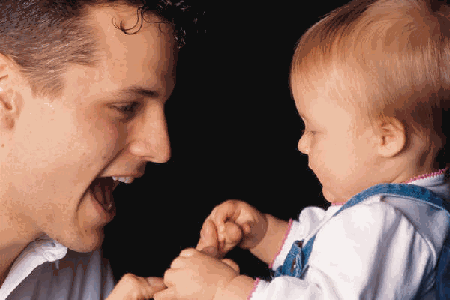Best Way to Understand the Language Development of a Child
It’s amazing that every child develops language in the same way, progressing through the same stages in the same order. Bear in mind that the following suggested ages are only approximate, and that wide individual variations are normal between children. At each stage, the child uses language in a new and more-sophisticated format:
- Cooing. Cooing usually begins around the age of eight weeks, and then disappears about twelve weeks later. Although at times a baby’s cooing sounds like words, it has no meaning whatsoever.
- Babbling (random). By the age of five months, an infant’s vocal chords have matured to the point where she can begin to experiment with pitch, vocal range, and breathing, in order to produce a range of sounds. Every child has her own distinctive patterns of noises at this age, and she uses them to communicate with any adult who pays attention to her. Psychologists have found that infants tend to produce the same kinds of babbling sounds, irrespective of their parents’ native language.
- Babbling (controlled). In the next couple of months, an infant gains more control over her sounds. Babbling becomes more conversational. Her sounds become related to the language used by her parents. She may repeat strings of sounds (such as babababababa), and may have a favorite sound that she uses consistently in the same situation.
- Early speech. Toward the end of her first year, a baby begins to use her sounds as though she is engaging in conversation. She may have an earnest expression on her face and make sounds using tones and emphasis found in adult speech.
- First word. By the age of twelve to fifteen months your child will probably have used her first word—she regularly uses a particular sound structure to refer to the same object or person. She may generalize this word to include anything that pleases her. Very often this first word is intelligible only to people who know her, but it is her first word all the same.
- Vocabulary growth. From the age of fifteen months onwards, an infant’s vocabulary increases spectacularly. Many two-year-olds are able to use more than two hundred words, although they understand many more.
- Sentences. By eighteen to twenty months, a typical toddler begins to combine two words together to make a short phrase or sentence—for example, “Dada gone” or “More juice.” From this moment on, throughout the remaining childhood years, your child’s ability to use sentences with more words and more-complex meanings continues to develop.
This similarity in terms of stages in the growth of language has enabled psychologists to plot key “milestones” of language development—significant points that most children pass at approximately the same age.
Categories
Advertisements
Recent Articles
 How to Understand Bed Sizes – A Small Guide
How to Understand Bed Sizes – A Small Guide How to Select Some Must Have Kitchen Accessories
How to Select Some Must Have Kitchen Accessories Best Way to Change a Car Tire
Best Way to Change a Car Tire Best Way to Write an Affirmation
Best Way to Write an Affirmation Best Way to Take Charge of Your Financial Life
Best Way to Take Charge of Your Financial Life Best Way to Survive a Party When You Don’t Know Anyone
Best Way to Survive a Party When You Don’t Know Anyone Best Way to Stop Self Sabotaging Yourself
Best Way to Stop Self Sabotaging Yourself Best Way to Start Journal Writing
Best Way to Start Journal Writing Best Way to Speak with a Powerful Voice
Best Way to Speak with a Powerful Voice Best Way to Simplify Your Life
Best Way to Simplify Your Life Best Way to Respond to a Put-Down
Best Way to Respond to a Put-Down Best Way to Reduce Acne Breakouts
Best Way to Reduce Acne Breakouts Best Way to Recover from Dining Disasters
Best Way to Recover from Dining Disasters Best Way to Quit Your Job Gracefully
Best Way to Quit Your Job Gracefully Best Way to Make Your Own Website
Best Way to Make Your Own Website
Tags
Acid Reflux
Allergy
Aromatherapy
Baby
Baby Learn
Beauty
Bed Rest
Child
Decorate Garden
Depression
Develop Baby Skills
Exercise
Feng Shui
Garden
Golf
Golf Swing
Growing Herbs
Hair
Herbs
Improve Garden
Interview
Interviews
Kitchen
Life
Makeup
Massage
Meditation
Newborn Baby
Plant
plants
Pregnancy
Reduce Stress
Relax
Sales Team
School
Skin
Skin Care
Stress
Stress Reducing
Teach Child
Teacher
Teaching
Train Dog
Understand Baby
Vegetable Garden



Leave a Reply